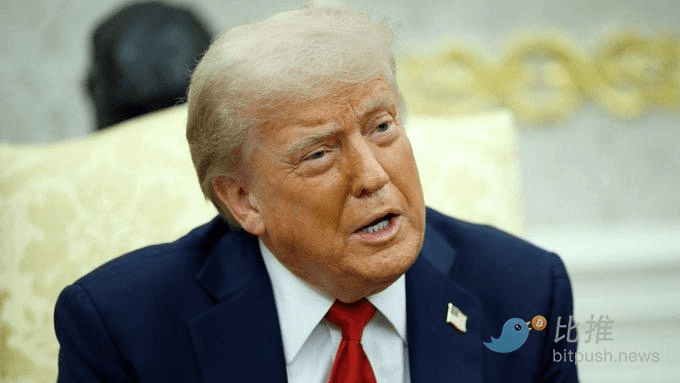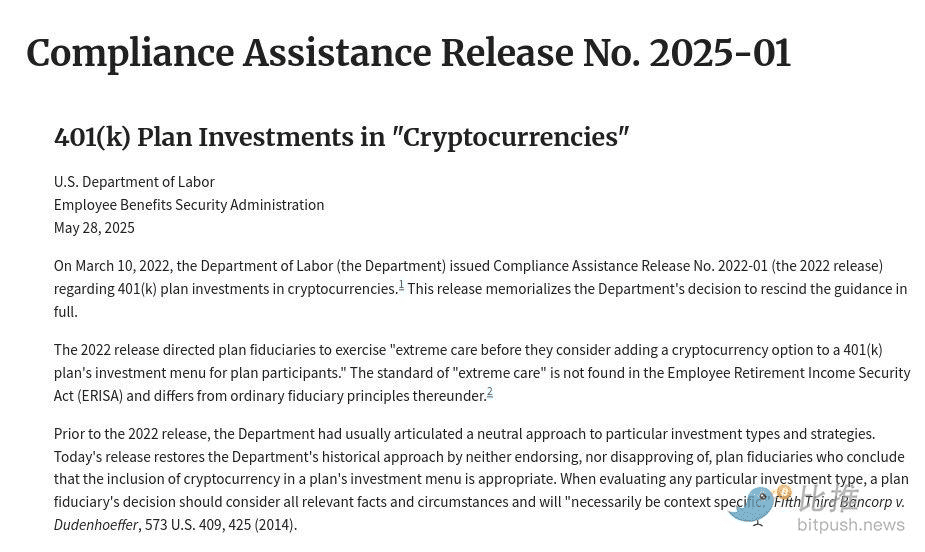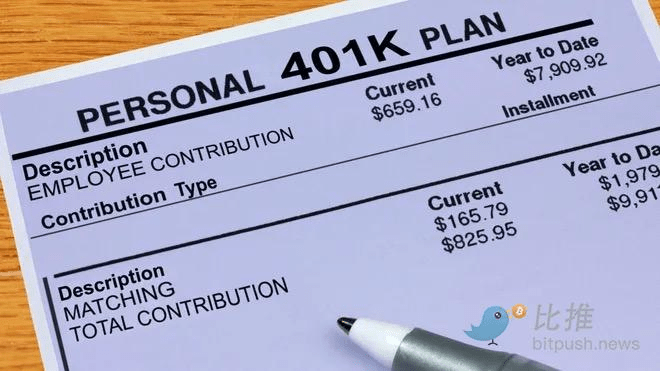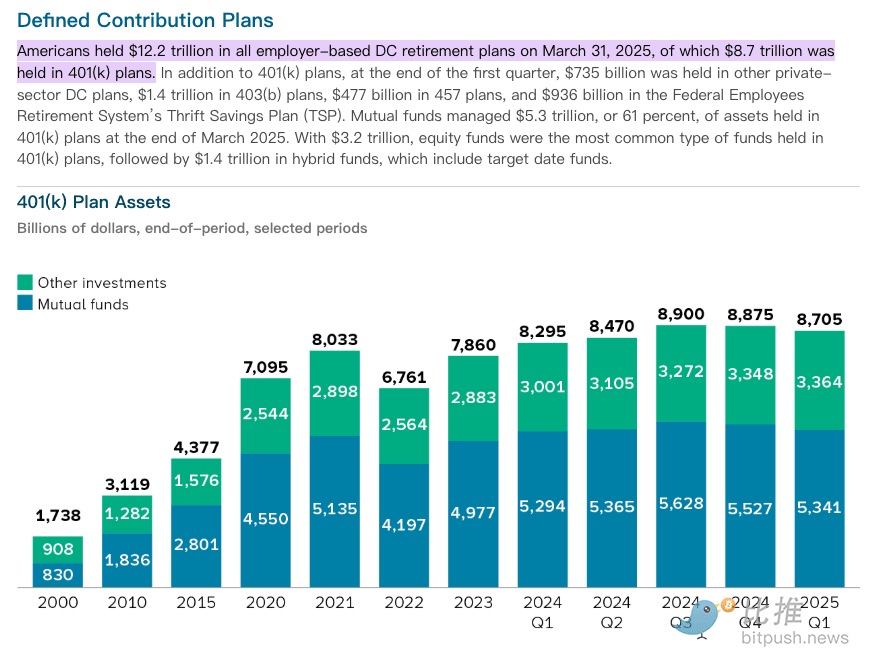Written by: BitpushNews
Overnight, the UK (Financial Times) broke significant news: President Trump is preparing to sign an executive order allowing pension plans like 401(k) to invest in cryptocurrencies, gold, and private equity as "alternative assets."
According to three informed sources, the order will require regulators to revisit current pension investment restrictions, clearing the way for digital assets to enter the $8.7 trillion U.S. pension market.

This trend did not come without warning. On May 28, the U.S. Department of Labor revoked the Biden-era guidance that treated cryptocurrency assets with "extreme caution," citing "regulatory overreach." Earlier in 2022, Republican Congressman Peter Meyer had proposed the (Retirement Savings Modernization Act) to attempt to include digital assets within the framework of the 1974 (Employee Retirement Income Security Act) (ERISA), which, although not passed, laid the groundwork for today's policy shift.
Trump's "digital asset" ambitions
The core intent of this executive order is to break the long-standing focus of the 401(k) plan on traditional stocks and bonds, granting it broader asset allocation flexibility.
The order will clearly instruct Washington's regulatory agencies to thoroughly investigate and begin removing the barriers that hinder alternative assets, particularly digital assets, precious metals, and funds focused on corporate mergers, private lending, and infrastructure transactions, from being included in the 401(k) professionally managed funds.
The White House cautiously stated in a statement to the (Financial Times): "President Trump is committed to restoring prosperity for ordinary Americans and securing their economic future. However, any decision should only be regarded as official policy once announced by the President himself." Nevertheless, this statement did not obscure the strong signal from the Trump administration to promote the mainstreaming of cryptocurrencies.
In fact, this move is a continuation of Trump's series of pro-crypto policies. From the campaign period, he promised to liberate digital currency from what he called "excessive regulation," to his family business—Trump Media & Technology Group spending over $2 billion to purchase Bitcoin and other digital currencies, and even launching its own stablecoin and other digital tokens, Trump himself has become a heavyweight player in the digital asset space, with disclosed cryptocurrency holdings exceeding $51 million.
Their government has also taken action, with the Department of Labor revoking policies from the Biden era that discouraged 401(k) plan managers from offering cryptocurrency investment options, paving the way for this executive order.

Interpretation: The deeper significance of opening the U.S. pension market
To understand the potential impact of this policy, one must look at the structure and scale of the U.S. pension market. As one of the largest pension systems in the world, the total size of the U.S. pension market reaches $9 trillion.
Specifically, according to public data, as of March 31, 2025, the total assets of all employer-led defined contribution (DC) retirement plans have reached $12.2 trillion. Among them, the most notable 401(k) plan holds $8.7 trillion.

These vast funds mainly come from tens of millions of American wage earners. The 401(k) plan, as an employer-sponsored occupational pension, is the core of long-term savings for the majority of working families due to its payroll deductions, tax benefits, and employer matching contributions.

Traditionally, these vast pensions have mainly flowed into publicly traded securities. As of March 31, 2025, $5.3 trillion (61%) of the 401(k) plans were managed by mutual funds. Among them, equity funds, with a scale of $3.2 trillion, have become the most common type, followed closely by mixed funds (including target date funds) managing $1.4 trillion. This asset allocation status dominated by stock and bond mutual funds provides a broad space for Trump's push for alternative investments to "break the ice."
The IRA (Individual Retirement Account) provides individuals with more autonomous retirement savings options. The wealth accumulated day by day by ordinary Americans constitutes a massive source of "long money" that drives U.S. economic growth and financial market stability.
Compared to China's pension system, the similarity lies in both striving to build a multi-tiered guarantee. China's "enterprise/professional annuities" share similar employer-sponsored attributes with the U.S. 401(k), while "personal pensions" are closer to the IRA's individual autonomous investment model. Therefore, the U.S. decision to open pension investments has global implications for the public's wealth allocation philosophy.
Private equity giants and new opportunities: the redistribution of a trillion-dollar cake
Besides cryptocurrencies, this executive order represents a potential feast for the world's largest private equity firms, such as Blackstone, Apollo, and BlackRock. These giants have largely pinned their future growth hopes on managing funds from ordinary retirement savers. The executive order will require the Department of Labor to consider providing a "safe harbor" mechanism for retirement plan managers to reduce the legal risks they face when offering high-fee, less liquid, and less transparently valued private investments to savers.
Private equity firms predict that once they successfully enter the 401(k) retirement plan market, they may attract hundreds of billions of dollars in new industry assets.
To this end, they have prepared in advance, actively establishing partnerships with large asset management firms: Blackstone has teamed up with Vanguard, while Apollo and Partners Group are also providing investment services for large 401(k) plan sponsors like Empower. BlackRock has also begun collaborating with retirement savings plan third-party management institution Great Gray Trust.
As federal-level policies are being formulated, some state governments have already piloted initiatives. Bitpush previously reported that North Carolina legislators proposed a bill allowing certain retirement funds to allocate up to 5% of their balance to cryptocurrencies. Retirement systems in Michigan and Wisconsin have also actually invested in spot Bitcoin and Ethereum ETFs, providing a reference for federal-level policies.
Challenges remain
In terms of legislation, the U.S. House of Representatives passed three important cryptocurrency-related bills on Thursday local time: the CLARITY Act, the GENIUS Act, and the Anti-CBDC Surveillance National Act. Among them, the CLARITY Act and the Anti-CBDC Surveillance National Act will be sent to the Senate for review. The GENIUS Act is expected to be signed into law by President Trump on Friday local time, marking substantial progress by Congress in promoting cryptocurrency legislation and providing a clearer legal framework for industry development.
However, even if the legislation brings good news, the market still faces challenges. Palisade co-founder Mantan Dave warned that if the U.S. ultimately fails to establish a clear and consistent regulatory framework, businesses may shift funds and innovation to markets with clearer rules. Furthermore, investing retirement savings into less liquid private assets is not without risks, as inherent high costs, higher overall leverage, and lower transparency in fund asset valuations are factors that regulators and investors need to consider carefully.
When Trump's executive order meets the $9 trillion retirement market, this experiment may redefine the meaning of "retirement savings"—will it allow ordinary people to share in the technological dividends of the digital age? Or will it expose retirement funds to new risks? The answer may depend on how regulators find a balance between innovation and protection.



